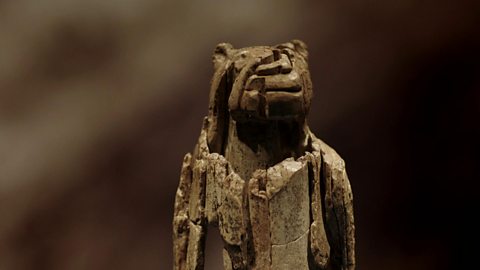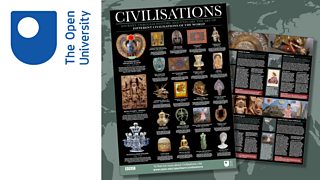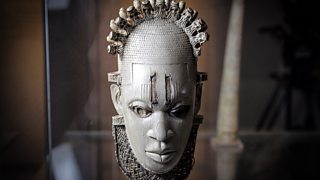"Useless" art: Why did a prehistoric artist make this sculpture?
1 March 2018
In Civilisations: Second Moment of Creation we see objects from the prehistoric period and get an incredible glimpse of a long-lost world. But from this point in history it is impossible to know for sure why these objects were made. Could recreating them today, using only the tools available at the time, offer our best hope of understanding the past?

Lion Man
The meaning behind a 40,000 year-old carving found in Germany in 1939.
He was set free by his community only to do this piece of artwork. If you do this you can’t go hunting, you can’t go fishing, you work all day on it.Wulf Hein
Using the techniques of prehistoric people, experimental archaeologist Wulf Hein recreated the Lion Man, a sculpture made around 40,000 years ago.
And something incredible was revealed in the process.
He said: "You scratch and scratch and days and days of working and working and blisters on my hands, my finger was aching".
It wasn’t just the pain that told Hein something but the sheer amount of time required. "In the end it was about four hundred hours then I stopped counting."
This was a revelation. "A real artist made this. He was set free by his community only to do this piece of artwork. If you do this you can’t go hunting, you can’t go fishing, you work all day on it."
Jill Cook, a curator from the British Museum, says that although the object was "useless for their physical survival", that doesn't mean that it wasn’t without value.
It might have been created, she suggests, for a wider purpose. "The image was about strengthening common bonds and group awareness to overcome dangers and difficulties."
Neil MacGregor, Director of the Humboldt Forum, sees a deep significance in how the original object was handled.
He said: "There was a story told by generation after generation around their fire, so that the Lion Man's torso became smooth as he was passed between them.
These people possessed something precious, a shared story, which showed each person their deep connection to one and other."
That story is lost to us but the Lion Man offers a fascinating glimpse into the customs of an ancient world.
Amazing cave discovery
It was in 1939, deep inside a cave in the mountains of southwestern Germany, that archaeologist Otto Völzing found the pieces of mammoth tusk that have become known as the Löwenmensch, or Lion Man in English.

Völzing had little time to consider the significance of the small splintered pieces of mammoth tusk he’d come across. Europe was on the verge of war and he was called up into the Waffen-SS.
The pieces were stored away and would not be assembled for decades.
Völzing did not discover all of the fragments though. Archaeologist Claus-Joachim Kind returned to the site in 2008 and over the course of three years hunted out several hundred more small pieces being found.

The Lion Man
Neil MacGregor tells the story of a small ivory sculpture, carved 40,000 years ago.
More from Civilisations
-
![]()
Hue knew? Five surprising facts about colour
Colour is a complicated and, at times, controversial topic.
-
![]()
Explore masterpieces of European painting
Five of the most significant paintings in the history of Western art.
-
![]()
Order a free poster from the Open University
OpenLearn, the OU’s home of free learning, helps you explore the art of different civilisations of the world.
-
![]()
Digital innovations
Explore artefacts using the augmented Reality (AR) app and 360 degrees videos, plus storytelling collaborations with UK museums and galleries.
-
![]()
The Czech and the Chieftains
How the Māori community turned the tables on colonial art.
-
![]()
9 fascinating facts from The Civilisations Podcast
Viv Jones' audio companion to the BBC Two series is taking us on some intriguing tangents.
-
![]()
The Inside Story
Mary Beard and Simon Schama reveal the inside story of writing and presenting the BBC Two series Civilisations.
-
![]()
Civilisations: Box set
Watch all nine episodes of the series on BBC iPlayer.







